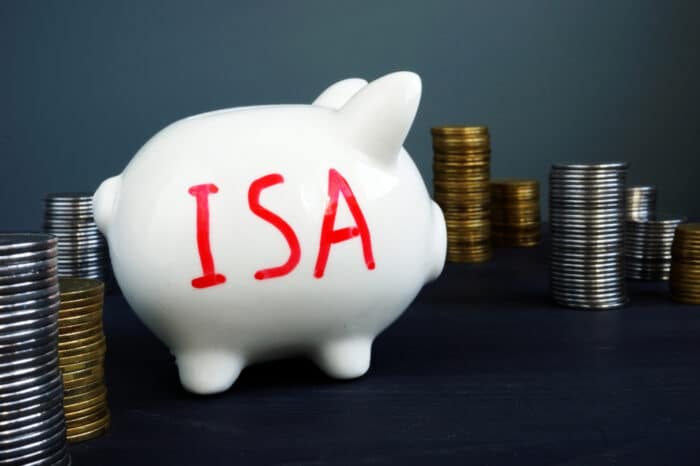
ISAs were introduced on 6 April 1999, replacing the personal equity plan (PEP) and tax-exempt special savings account. At the start, the contribution limits were £7,000 for a stocks and shares ISA, and £3,000 for a cash ISA. This was an uplift on the £6,000 limit for a PEP, but a long way short of today’s £20,000 annual limit.
According to HMRC and Office for National Statistics (ONS) figures, more than 22 million adults hold an ISA, with a total of about £750bn held in ISA accounts.
This includes about £456bn invested in stocks and shares ISAs, and £285bn in cash ISAs. A further £9bn is held in Junior ISAs for children, with £5bn in investment accounts and £4bn held in cash.
How much are ISAs worth?
According to AJ Bell’s analysis of Government data, the average account is worth more £30,000, although older holders of these accounts hold nearly £60,000 on average.
Around 1.6 million account holders used the full £20,000 annual ISA allowance, according to HMRC’s most recent figures, equating to roughly 7% of all holders.

Wellness and wellbeing holidays: Travel insurance is essential for your peace of mind
Out of the pandemic lockdowns, there’s a greater emphasis on wellbeing and wellness, with
Sponsored by Post Office
Most people pay in far smaller amounts – over five million people paid in £2,500 or less, with just less than half (47%) of all ISA subscriptions falling into this bracket.
The gender investing gap sees more than 40% of male ISA holders investing, while just a quarter (26%) of women are putting their ISA money into stocks and shares.
There are more than six million ISA users aged over 65, meaning half the population in this age group have ISAs. There are plenty of young people using them too, with almost a third (32%) of 18-25-year-olds holding one of these accounts.
Laura Suter, director of personal finance at AJ Bell, said: “The figures highlight that almost 60% of the population isn’t using an ISA at the moment, where they could potentially benefit from one.
“Whether that’s people using a dealing account where they could be using an investment ISA, or people saving for children in a cash savings account where a Junior ISA might work better, or someone with old paper-based investments who could move them into an online ISA – there is clearly a gap where more people could benefit from ISA tax breaks.”
The best performing funds
The FundCalibre research team has looked at the success of the ISA-eligible funds that have delivered the best returns over the past 25 years.
The top-performing retail investment fund was the UK-focused IFSL Marlborough Special Situations. Launched in July 1995, it has delivered a 2,643% return over the past 25 years.
An investor who had put their £7,000 ISA allowance into this fund in 1999 would now be sitting on a pot of £192,026. In comparison, someone who saved the £7,000 in a cash ISA would have about £14,656 now.
Another high performer over the period has been Liontrust UK Smaller Companies. The fund has delivered 1,271% since April 1999, turning £7,000 into £95,976 for investors.
Darius McDermott, managing director at FundCalibre, said: “Those who have saved in stocks and shares ISAs since the beginning will have done pretty well. An investment in the MSCI World index would have delivered a comfortable return of 468%. That is in spite of plenty of bumps on the way – the technology boom and bust, the global financial crash, and a variety of geopolitical crises.”
How to make the most of ISAs
- Be careful about cash
As the figures above show, stocks and shares deliver much better returns than cash.
Tim Bennett, head of education at Killik & Co, said: “Every day that money sits in cash, it is being eroded by inflation. Interest rates rarely keep up with inflation, even when allowing for the tax protection afforded by an ISA.”
- Use up your allowance
There is no way of carrying over unused allowances from one tax year to the next. This is in contrast to pensions, where up to three years’ worth of allowances may be carried forward to then be used up.
Don’t forget that it can take a few days to clear the relevant funds from a bank account, so try to avoid leaving this right until the last minute.
- Don’t keep checking in
Bennet said: “Many people sensibly fill up their ISA via an app. After all, they are a simple, portable way to save and invest. However, the downside is that they regularly update the overall balance, and it can therefore fluctuate daily according to what is happening across markets.
“The secret to successful long-term investing is not to be drawn into tinkering with an ISA – it is not a cash point machine, and any balance should be left alone to grow.”
- Avoid withdrawals
You should only make withdrawals from an ISA over short-term periods, if at all. That is because if you pull money out and then reinvest it again within the same tax year, the associated tax benefits are preserved.
However, anyone who misses the end of tax year deadline to reinvest loses ISA protection on those funds forever.




